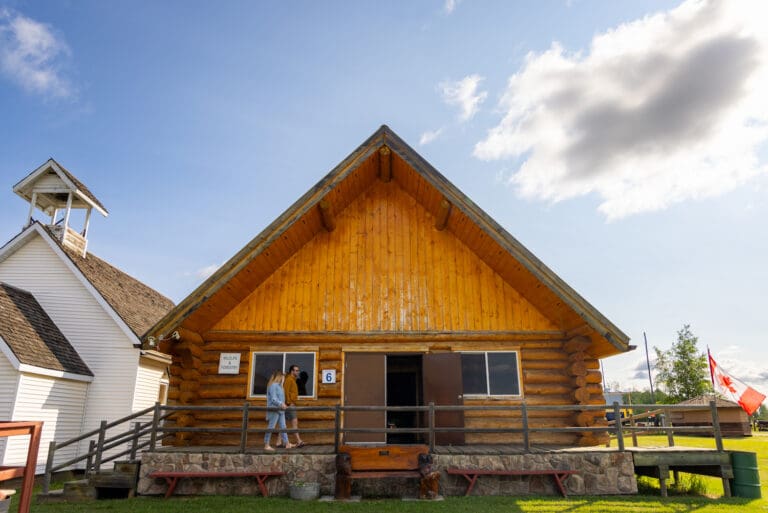No Records Found
Sorry, no records were found. Please adjust your search criteria and try again.
Google Map Not Loaded
Sorry, unable to load Google Maps API.
-
SavePlace Title: End of Steel MuseumPlace Description:
END OF STEEL MUSEUM
Bringing the homesteading history of Hines Creek to life.
The End of Steel Museum opened to the public in 1985 and has been growing and evolving ever since. The museum celebrates the history of the Hines Creek area which is unique because it was the end of the railway line. The tracks were built only to the point that freight rates would have increased and no further. This entailed the moving of the village, from its original site on the creek from which it takes its name, to the present day location. Hines Creek became a transportation hub with the arrival of the first train in December of 1930 and at one point there were five grain elevators along the tracks.
The museum has three historic houses: the Pohaboff House (1928) which is a good example of the sort of small hand-hewn log house built by arriving immigrant settlers; the Carter House (1938) is an unusually large and somewhat grand home, especially as it was built during the Great Depression as Art Carter (of Carter Camp) owned a sawmill; the French “Half-House” (1948-1949) is exactly that, only half the two story home was ever constructed due to financial problems, the staircase is incredibly narrow. These three homes are furnished with time appropriate artifacts to give visitors the feeling that the owners’ might return at any moment.
Hines Creek School #4430 is a one room log structure which allows one to imagine what it must have been like to ride to school three on a pony or try to learn when it was so cold out that the wood stove had to be stoked to the point that it was quite literally red hot. There are two historic churches, Christ Lutheran Church (1928-1932) preserved and restored by children of the original builders and St. James Anglican (1938) was erected through a donation from the Women’s Auxiliary of St. James Anglican Church in Stratford, Ontario, prior to that the congregation had to make due with meeting in schools and homes and with Miss Eva Hasell’s Sunday School Caravan.
The museum also has a Trapper’s log cabin which while not that old (1975) is no different from a much earlier trapper’s cabin. Although tiny and crude, the temporary shelters resorted to while out on the trapline made this a welcome home base. We also have a caboose, NAR 13021 which was built in Montreal in 1949, and served as bedroom, office, and kitchen for three railmen. In 1945 Morgan’s Confectionary began as John and Mary Morgan’s clothing store, later the couple also had a cafe, grocery, the bus depot and sold all manner of licenses in Hines Creek, after John’s passing in 1967 Mary returned and started the confectionary, running it until she was 91.
The Wildlife and Forestry exhibits are housing in a stunning contemporary log building. Inside it boasts an amazing display of local wildlife set in an autumn boreal forest and a comprehensive display of the sort of hand tools that were used to build settlers homes, as well as early chain saws. We also have a large collection of agricultural equipment and machinery, hand tools and early tractors and vehicles, including a Bombardier “Nodwell” the track vehicle that kept the Canadian north connected. Two projects we are currently working on are a Ukrainian Heritage building and a working blacksmith’s shop in our new Blacksmith building.
Lubeck Hall is a good example of the sort of community hall that dotted the area, built so that the scattered farm population could have a place to come together, to dance and play and get the news. Today is the location of our Saturday Farmers’ Market, which is a popular place to chat over a cinnamon bun hot out of the oven and a cup of coffee.
SPECIAL EVENTS
Pancake Breakfast, 8:30 – 11:00, Canada Day, July 1st.
Adults $10:00, Children 6 – 12 $5.00, Children under 5 free.
Pancakes with fresh berries, whipped cream and syrup, ham and eggs make for a delicious breakfast and Morgan’s Confectionary is decorated to celebrate Canada Day!
Heritage Day, 8:30 – 6:00, Monday of the August long weekend.
Entry by Donation.
A pancake breakfast begins the day followed by demonstrations of pioneer crafts, log sawing, an antique tractor parade, horse drawn wagon rides, bannock baked over an open fire, blacksmithing demonstration, petting zoo, games for children, a country market, bread baked in our historic outdoor clay oven, live music, and of course, tours of the museum buildings. There will be hamburgers, hot dogs, homemade pie and ice cream, lemonade and iced tea for sale starting at noon.
INFORMATION
LOCATION
The museum is located at the intersection of Highway 64 and Highway 685, the southern most of the two exits for Hines Creek.
Mailing Address: End of Steel Museum, Box 686, Hines Creek, AB, T0H 2A0
CONTACTS
Office: 780-494-3522 (Answering Machine)
Curator: 780-834-6538 Jean Young (Wed. – Sat.)
Bookings: 780- 835-7827 (Weddings, School Tours, Hall Rental)
Email: hinescreekmuseum@gmail.com
Website: endofsteelmuseum.weebly.com
HOURS
Open mid May to mid Sept.
Monday to Saturday 10:00 – 6:00
Sunday 1:00 – 6:00
Last tour of buildings 4:30
Tags: Edu-vacationAddress: Hines Creek
Hines Creek
Alberta
CanadaEND OF STEEL MUSEUM
Bringing the homesteading history of Hines Creek to life.
The End of Steel Museum opened to the public in 1985 and has been growing and evolving ever since. The museum celebrates the history of the Hines Creek area which is unique because it was the end of the railway line. The tracks were built only to the point that freight rates would have increased and no further. This entailed the moving of the village, from its original site on the creek from which it takes its name, to the present day location. Hines Creek became a transportation hub with the arrival of the first train in December of 1930 and at one point there were five grain elevators along the tracks.
The museum has three historic houses: the Pohaboff House (1928) which is a good example of the sort of small hand-hewn log house built by arriving immigrant settlers; the Carter House (1938) is an unusually large and somewhat grand home, especially as it was built during the Great Depression as Art Carter (of Carter Camp) owned a sawmill; the French “Half-House” (1948-1949) is exactly that, only half the two story home was ever constructed due to financial problems, the staircase is incredibly narrow. These three homes are furnished with time appropriate artifacts to give visitors the feeling that the owners’ might return at any moment.
Hines Creek School #4430 is a one room log structure which allows one to imagine what it must have been like to ride to school three on a pony or try to learn when it was so cold out that the wood stove had to be stoked to the point that it was quite literally red hot. There are two historic churches, Christ Lutheran Church (1928-1932) preserved and restored by children of the original builders and St. James Anglican (1938) was erected through a donation from the Women’s Auxiliary of St. James Anglican Church in Stratford, Ontario, prior to that the congregation had to make due with meeting in schools and homes and with Miss Eva Hasell’s Sunday School Caravan.
The museum also has a Trapper’s log cabin which while not that old (1975) is no different from a much earlier trapper’s cabin. Although tiny and crude, the temporary shelters resorted to while out on the trapline made this a welcome home base. We also have a caboose, NAR 13021 which was built in Montreal in 1949, and served as bedroom, office, and kitchen for three railmen. In 1945 Morgan’s Confectionary began as John and Mary Morgan’s clothing store, later the couple also had a cafe, grocery, the bus depot and sold all manner of licenses in Hines Creek, after John’s passing in 1967 Mary returned and started the confectionary, running it until she was 91.
The Wildlife and Forestry exhibits are housing in a stunning contemporary log building. Inside it boasts an amazing display of local wildlife set in an autumn boreal forest and a comprehensive display of the sort of hand tools that were used to build settlers homes, as well as early chain saws. We also have a large collection of agricultural equipment and machinery, hand tools and early tractors and vehicles, including a Bombardier “Nodwell” the track vehicle that kept the Canadian north connected. Two projects we are currently working on are a Ukrainian Heritage building and a working blacksmith’s shop in our new Blacksmith building.
Lubeck Hall is a good example of the sort of community hall that dotted the area, built so that the scattered farm population could have a place to come together, to dance and play and get the news. Today is the location of our Saturday Farmers’ Market, which is a popular place to chat over a cinnamon bun hot out of the oven and a cup of coffee.
SPECIAL EVENTS
Pancake Breakfast, 8:30 – 11:00, Canada Day, July 1st.
Adults $10:00, Children 6 – 12 $5.00, Children under 5 free.
Pancakes with fresh berries, whipped cream and syrup, ham and eggs make for a delicious breakfast and Morgan’s Confectionary is decorated to celebrate Canada Day!
Heritage Day, 8:30 – 6:00, Monday of the August long weekend.
Entry by Donation.
A pancake breakfast begins the day followed by demonstrations of pioneer crafts, log sawing, an antique tractor parade, horse drawn wagon rides, bannock baked over an open fire, blacksmithing demonstration, petting zoo, games for children, a country market, bread baked in our historic outdoor clay oven, live music, and of course, tours of the museum buildings. There will be hamburgers, hot dogs, homemade pie and ice cream, lemonade and iced tea for sale starting at noon.
INFORMATION
LOCATION
The museum is located at the intersection of Highway 64 and Highway 685, the southern most of the two exits for Hines Creek.
Mailing Address: End of Steel Museum, Box 686, Hines Creek, AB, T0H 2A0
CONTACTS
Office: 780-494-3522 (Answering Machine)
Curator: 780-834-6538 Jean Young (Wed. – Sat.)
Bookings: 780- 835-7827 (Weddings, School Tours, Hall Rental)
Email: hinescreekmuseum@gmail.com
Website: endofsteelmuseum.weebly.com
HOURS
Open mid May to mid Sept.
Monday to Saturday 10:00 – 6:00
Sunday 1:00 – 6:00
Last tour of buildings 4:30
-
SavePlace Title: World’s Largest Railroad SpikePlace Description:
Where is the World’s Largest Railroad Spike? In Hines Creek!!
When WWII broke out, construction on the railroad in northern Alberta came to a halt – in Hines Creek. The line sat unfinished until well after the war was over, but has long since completed. During the time after the war, the town become known as “the end of steel”, a moniker it has kept ever since.
Address: Hines Creek
Hines Creek
Alberta
T0H 2A0
CanadaWhere is the World’s Largest Railroad Spike? In Hines Creek!!
When WWII broke out, construction on the railroad in northern Alberta came to a halt – in Hines Creek. The line sat unfinished until well after the war was over, but has long since completed. During the time after the war, the town become known as “the end of steel”, a moniker it has kept ever since.





